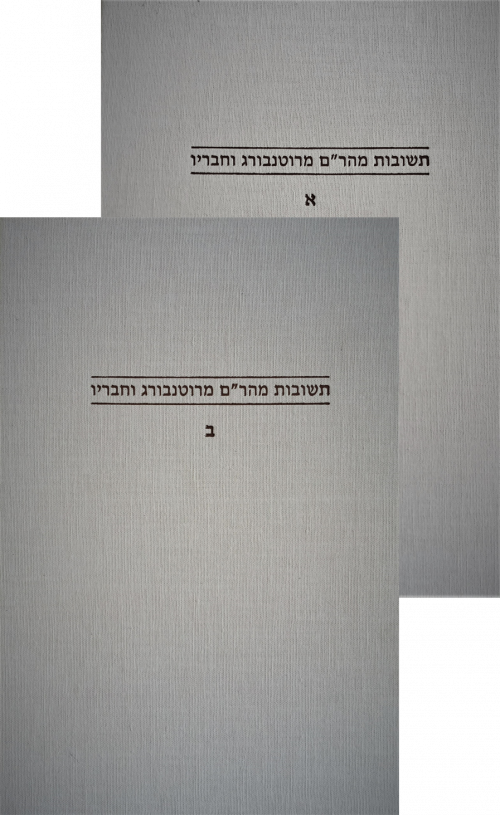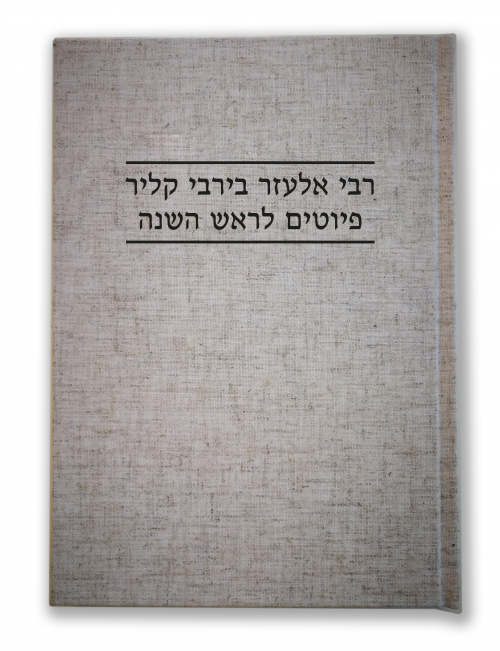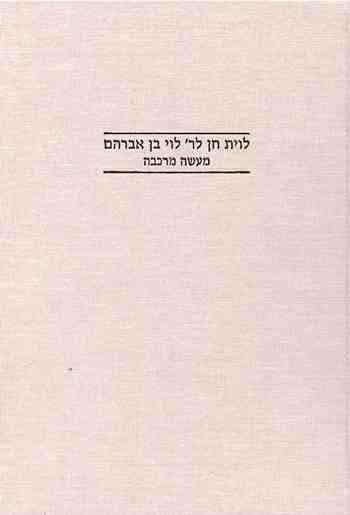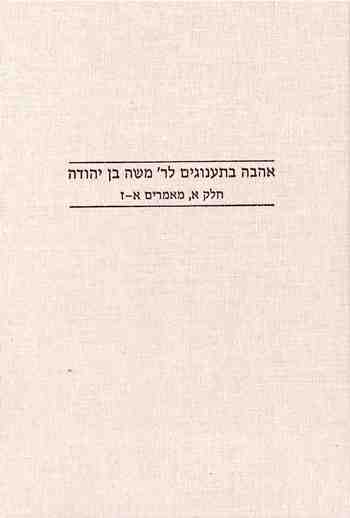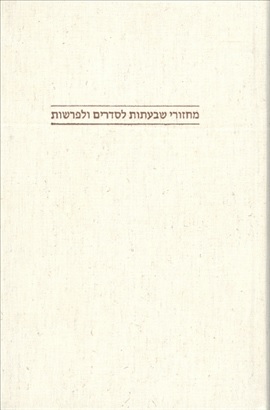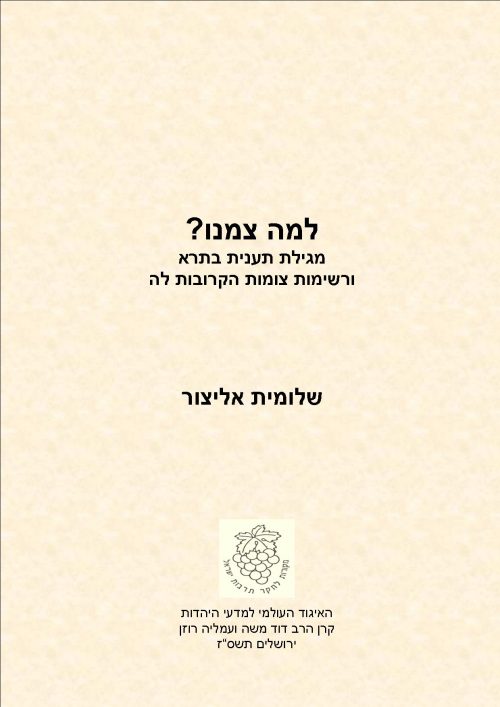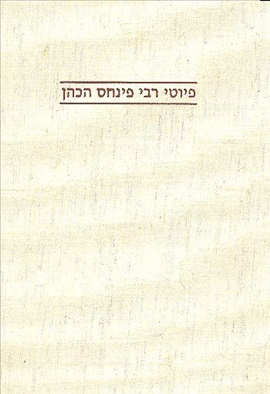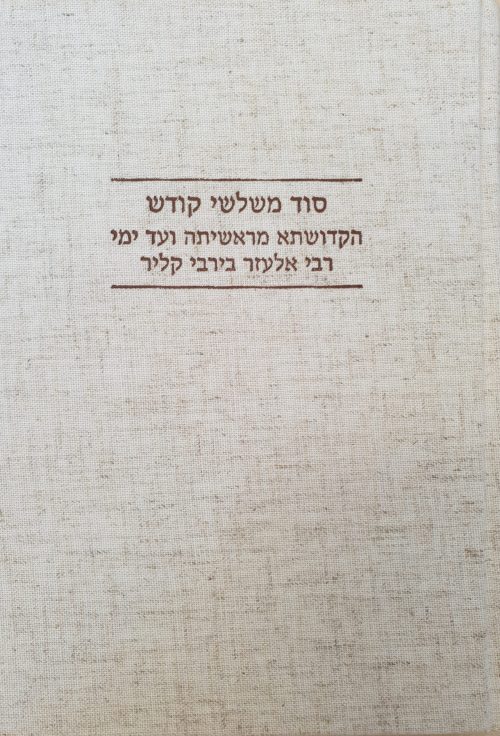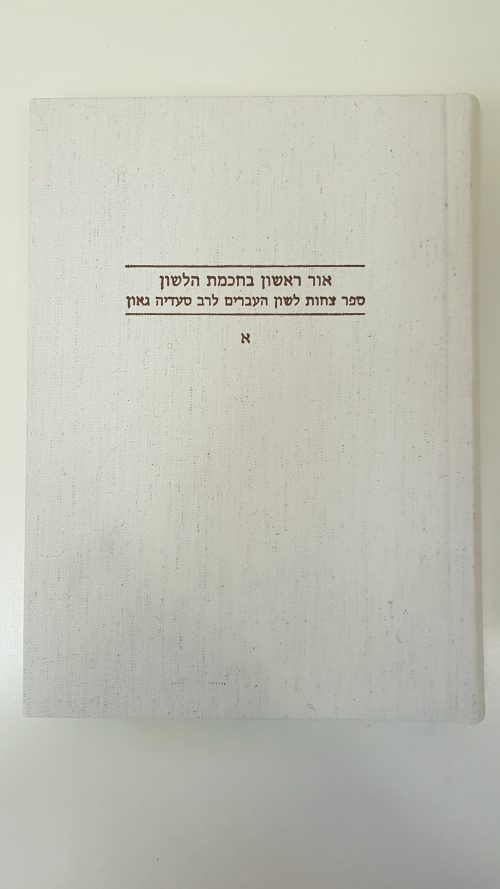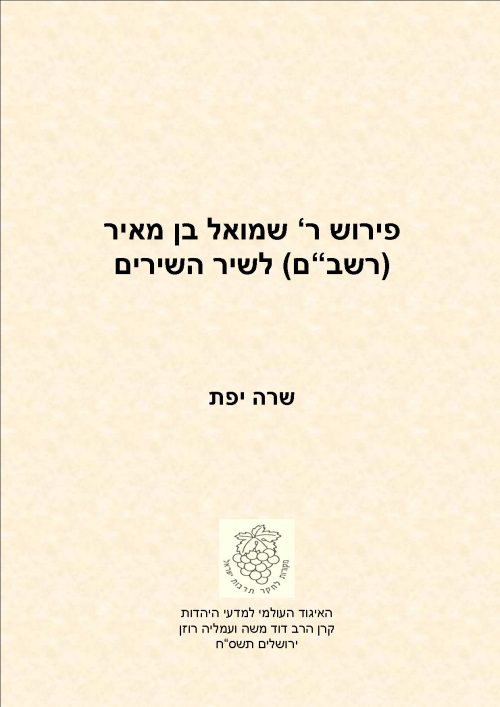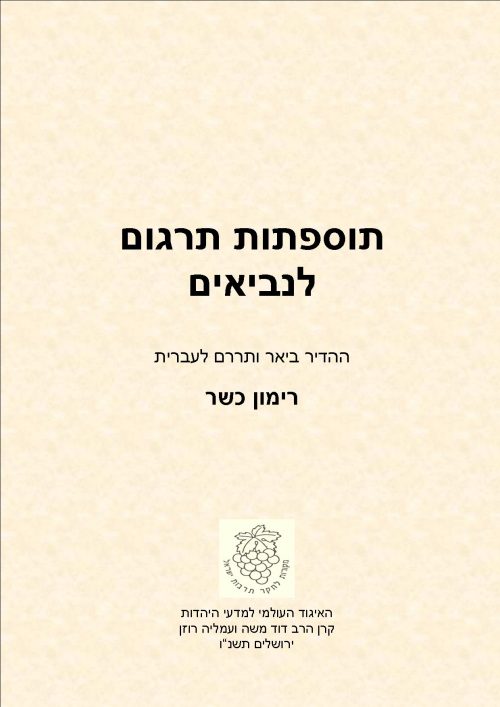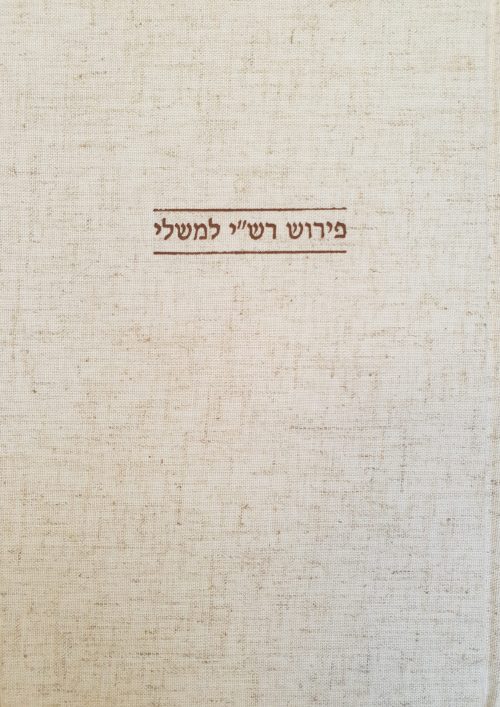-
Sale!
Meir of Rothenburg (c. 1215 – 2 May 1293) was a German Rabbi and poet, a major author of the tosafot on Rashi's commentary on the Talmud. He is also known as Meir ben Baruch, the Maharam of Rothenburg. His responsa are of great importance to advanced students of the Talmud, as well as to students of Jewish life and customs of the 13th Century.
-
Sale!
This book is devoted to the compositions that were written for Rosh Hashana by the illustrious poet R. El‘azar berabbi Qillir, who was active in the Land of Israel at the beginning of the seventh century. The piyyutim for Rosh Hashana are many and varied, and they adorn all of the special prayers for the festival. A number of these piyyutim are known and recited to this day in Ashkenazi congregations, while others are published here for the first time. This edition has been prepared on the basis of close to 400 manuscripts, and all of the variant readings have been given in the margins. An extensive commentary aids the reader in understanding the difficult idiom of the payyetan, identifying the many scriptural and midrashic sources that are woven into the piyyutim, and following the development of their themes.
-
Critical annotated edition of part one of treatise seven of R. Levi's encyclopedia, which is devoted to an exegesis of the "Work of the Chariot". This volume also contains an edition of the surviving section of treatise five of the encyclopedia ("Divine Science") and a critical edition of the section of the poem "Battei ha-Nefesh ve-ha-Laḥashim" devoted to the "Work of the Chariot", together with the four medieval commentaries written on this section. The introduction to this volume discusses at length the interpretation of the "Work of the Chariot" from rabbinic times to R. Levi. Towards the end of the thirteenth century, the Provençal Jewish philosopher R. Levi ben Avraham wrote a unique treatise – an in-depth Hebrew encyclopedia of the sciences and of Judaism entitled Livyat Ḥen. R. Levi was known already in his lifetime as a leading exponent of the philosophical-allegorical interpretation of the Torah and of rabbinic midrash. In the Jewish part of his encyclopedia he deals with a myriad of topics, including Jewish ethics, prophecy, the reasons for the commandments, the stories of Moses and the patriarchs, the principles of faith, the Work of Creation, the Work of the Chariot, and the interpretation of rabbinic midrash and aggadah. Prior to Livyat Ḥen R. Levi wrote an encyclopedic poem of over 1000 stanzas in rhymed meter entitled Batei ha-Nephesh ve-ha-Laḥashim. This poem is devoted to the same topics in science and Judaism that are later discussed in great detail in his treatise.
-
Sale!
The book Ahava ba-Taanugim (Love In delights) was written during the years 1353 – 1356 by Rabbi Moses Ben Judah. It is a huge and comprehensive encyclopedia of Aristotelian physics and metaphysics and includes also a substantial theological section. Its author discusses and explains each scientific topic in a creative and innovative way: Some explanations on matter, atoms, time and motion, have no source in the classical Aristotelian literature. These innovations contributed to the development of sciences of the author's days and they reflect new trends of the study of Aristotle's philosophy of nature among the 14th century scholars. These trends paved the ground for modern science that, as modern scholarship observed, did not emerge ex nihilo, but had its roots in the criticism of Aristotelian science in the 14th century. The current book is a critical edition of the first seven discourses of the first part of the encyclopedia, which deals with physics. Each discourse deals with one scientific topic and includes some biblical commentarial chapters that aim to show the harmony between the scientific topic and the Torah and to expose the secrets that were hinted by Ibn Ezra, Maimonides and Nachmanides in their treatises. The edition includes an introduction which presents a general overview of the treatise: its period, place and its purpose, its sources and its approach. The introduction also describes and explains the content of the seven discourses presented in the edition and highlights its innovations and main original explanations. This book is in Hebrew edition only.
-
Sale!
This book represents a first attempt to assemble liturgical poems in a scientific edition according to their genre rather than according to authorship. All the Shiv‛atot cycles (liturgical poems for shabbat Amidah prayer) composed according to the order of the weekly Torah portion have been collected from the Genizah manuscripts. The book presents three main cycles, representing three stages in the history of liturgical poems: The remnants of an ancient Shiv‛atot cycle (composed around the sixth century) which was dedicated to the reading order of the Eretz-Israel triennial cycle, and two Shiv‛atot cycles for the annual cycle’s tractates – one of which was probably composed around the ninth or tenth century and remains loyal to the classical traditions of the genre, and the second, probably composed at the end of the tenth century or the beginning of the eleventh, which reflects a stage in which the later poets abandoned the ancient patterns or restricted them. Alongside these cycles, sections of other Shiv‛atot cycles whose remnants were found in the Genizah are included. The poems are printed in their entirety, with variant manuscripts readings and detailed notes. The book opens with an introduction that describes each cycle in detail and examines the development of the genre over the generations.
-
Sale!
For over fourteen hundred years, since post-Talmudic times, a list of fast days has been in circulation; it mandates at least one, but occasionally two, three, and even four fasts per month. These fasts commemorate disasters that occurred during biblical and Second Temple times; events connected with the Temple’s destruction; and the deaths of well-known individuals. The list penetrated into central halachic works; in some circles these events are commemorated to this day, albeit not by fasting. This list is known as Megillat Taʿanit Batra, “the later scroll of fasts,” to distinguish it from Megillat Taʿanit, which originated in the Second Temple period. This book traces the historical development of the list. The author has culled previously unknown versions of this list from manuscripts, early piyyutim, and other surprising sources. All these versions of the list are discussed in detail; a synoptic analysis of each fast, as presented in the various sources, attempts to solve some of the riddles presented by the texts. Towards the end of the book, a detailed chapter deals with the complex occurrences of the list in halachic literature. The final chapter sets out the internal structure of the list; attempts to arrive at its original form; and maps its metamorphoses through time.
-
Sale!
This book presents Piyyutim (liturgical poetry) written by one of the most important poets in the Land of Israel, Rabbi Pinhas Hacohen birabi Yaacov, who lived in the area of Tiberias in the 8th century. The Piyyutim are taken from manuscripts of the Cairo Genizah, and are published for the first time. R' Pinhas seals the classic period of early Paytanim (authors of liturgical poetry) in the Land of Israel. His work preserves the variety of genres typical for classic Piyyutim, yet shows early signs of developments characteristic to late Eastern liturgical poetry. R. Pinhas' Piyyutim reveal a great poet with impressive compositional durability. In some of them he reaches unique climaxes, especially through dramatic developments in the Piyut.
-
Sale!
A qedushta is a series of piyyutim for the ‘Amida prayer, which is expanded in honor of the recitation of the Qedusha, and includes many complex components. Its origins are in the Land of Israel, in the fourth or fifth century. We first see it as a constructed composition with set, complex, rules in the work of the poet Yannai, who lived in the mid-sixth century, the teacher of Rabbi El‛azar berabbi Qillir (who is known popularly as “the Qallir”). The qedushta, as it appears in the hundreds of compositions by Yannai and his followers, conceals many secrets: mysterious strings of biblical verses accompany its first components; a fixed biblical verse concludes the third component, followed by the strange words “El Na”; then comes a fourth component, whose structure is free, and always concludes, for some reason, with the word “Qadosh”; the fifth component in Yannai’s compositions is the ‘asiriya, a poem constructed of a truncated alphabetical acrostic from only aleph to yud, followed by a prayer beginning “El Na Le‘olam Tu‘aratz” – and it is unclear why this prayer appears here; then there is a group of poems called rahitim, which are written, for some reason, in unique, stereotypical structures. These are only a fraction of the various strange features of the qedushta’ot of Yannai and the other poets. The discussions in the book are dedicated to suggesting solutions to all these questions, and to others, and involve uncovering fragments of qedushta’ot that preceded Yannai; by examining these texts, they excavate the literary remains to construct a model of the gradual development of the qedushta over time, from its origins until it reached its complex structure in the days of Yannai and Rabbi El‛azar berabbi Qillir. The first section of the book, which is the largest, is devoted to this development of the qedushta, in all its elements, including those that follow the recitation of Qedusha. Naturally, this section deals with the piyyutim mostly from a structural point of view, for only such an analysis can enable a comprehensive look at the development of the genre. However, as a base for these structural analyses, this section contains the texts of many piyyutim, mostly pre-classical (from the period before Yannai, when the poets did not yet use rhyme). Alongside them are printed classical rhyming piyyutim, too, from the period of Yannai and his colleagues, and, in a few instances, even piyyutim from later periods. The second section of the book focuses on one single poet: Rabbi El‛azar berabbi Qillir, the most prolific of the classical poets in the Land of Israel, whose poems reached Europe, and some of them are recited in Ashkenazic and Italian synagogues through today. The qedushta’ot of Rabbi El‛azar berabbi Qillir are varied in both their structures and their styles, much more than those of Yannai; this section is devoted to an analysis of these compositions, and an attempt to map out which ones are earlier and which later. On the basis of precise structural analysis, the section builds a higher level of analysis – stylistic; and thus, we see the picture of the great poet’s literary journey. It becomes clear that when he was started out, he was heavily influenced by the work of Yannai, and slowly he created new ways for himself: at first he went in the direction of obscurity and difficulty, which he gradually made more and more obscure; but then, in a later, more mature phase, he turned to pure lyrical song, which today’s reader, too, will find sweet. The third section leaves aside the structural analyses, and suggests directions for further research. This section is short, and contains only first steps towards new directions in piyyut analysis. It focuses primarily on content, and ways that the qedushta’ot are organized, but it moves on to questions of how the qedushta is constructed as a complete composition, and points out various difficulties that the poets needed to overcome, and analyzes at length their literary solutions to these problems. Yannai stands at the center of the discussion in this section, but there are also notes about other poets. Most of the suggested directions for further research are new, and we hope that they will lead to further productive scholarship, and make it possible to study the piyyutim from angles that have hitherto been less examined. Throughout the book, phenomena are demonstrated by means of the texts of piyyutim. More than 250 piyyutim are printed in the book, of which about 130 are being printed for the first time. Most of these piyyutim are from the earlier periods of piyyut, and their publication in this volume reveals the full contribution of these layers of the genre to our understanding of the history of the qedushta. Even the piyyutim that have already been printed elsewhere often were published in out-of-the-way publications, some of them with no vowels or commentary. It goes without saying that for this volume, these texts were all printed anew straight from the manuscripts. When pieces from Yannai’s work are cited to exemplify some point, an attempt has been made, inasmuch as possible, to use pieces that have not been included in the existing publications of his work, and thus the volume contributes a great amount of new material to the corpus of Yannai’s piyyutim. The volume as a whole is based on examination of hundreds of manuscripts, mostly from the Cairo Geniza, and these provide a wide, firm textual basis to the analysis. The book is intended first and foremost for scholars, but it will also enable people interested in piyyut and its history from outside the world of academia to gain exposure to a great corpus of early piyyutim, among which are several stunningly beautiful gems, which are being published here for the first time.
-
The Book of Elegance of the Hebrew Language is Saadia Gaon's (892-942) Judeo-Arabic work on Hebrew linguistics. It is the first Hebrew grammar book, describing for the first time the Hebrew language, its letters, the vowels and the shewa, the dageshs, the influence of the gutturals, the inflections etc. The edition comprises of two volumes: the first is the introduction describing the work and its date, its structure and relationship to other works, with an analysis of the linguistic theory and the various grammatical issues as well as a comprehensive vocabulary of terminology, a complete survey of the chapters, a description of the manuscripts and method of editing and finally an extensive bibliography. The second volume hold the original Arabic text with a Hebrew translation by the editor, and apparatus of various readings and numerous commenting notes and indices.
-
Sale!
This commentary was first published in 1855 in the Aharon Yelink Edition of the 32 Hamburg manuscripts and was welcomed happily by the Jewish Sages of that generation, however it was quickly forgotten and its relation to Rashbam was distrusted. The damaged edition, in which it was published, did not benefit it either, and it hardly left any impression on the Biblical research of the new age. The current essay is a revised scientific edition of the commentary, based on all the known wording testimonies known today: Three complete manuscripts, two segments of other manuscripts and another written testimony of another manuscript which we do not hold. The commentary's edition is preceded by a comprehensive preface which deals with a wide range of subjects: identifying the commentary's author, its affinity to other essays by Rashbam, the sources of the commentary, the literary aspects of the commentary, allegoric commentary of Song of Songs and his message according to his time and era, verbal issues in the commentary and an introduction to this edition.
-
Sale!
Along with the official Aramaic translation of the Prophets, known as "Targum Yonatan", other Aramaic translations were circulating in the Jewish communities. These translations, most of which are found in manuscripts, are referred to in the modern research as "Translation Supplements" (Toseftot Targum), some of which have Midrashic extensions. The source of the translation additions is vague: they may be part of a complete Palestinian translation of the prophets, and they may be translations of the Haftoroh chapters only. The book contains a collection of one hundred and fifty texts, with a varied dialectical nature collected from over a hundred manuscripts and first editions.
-
Sale!
Rashi was the first Biblical Commentator in Northern France (Ashkenaz) to compose a comprehensive commentary to the Book of Proverbs, and this commentary has survived in 55 manuscripts scattered in libraries throughout the world. For the first time we present a critical edition of this commentary to Proverbs. This critical edition is based on MS New York JTS Lutzki 778. Variant readings from six other accurate manuscripts, the two earliest printed editions, and three later printed editions appear in the apparatus of variants. The edition also contains a “super-commentary” in which difficult words & sections in need of clarification are explained. The editor searched for Rashi’s sources - both those explicitly stated and those not. Preceding the critical edition is an introduction which analyzes important topics such as: interpolations to the commentary, Rashi’s exegetical approach, language & syntax and the Jewish-Christian debate.

